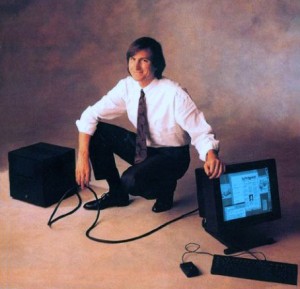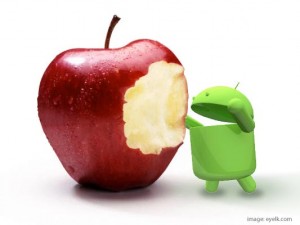[imagebrowser id=1]
 (NOTA: este artigo foi publicado aqui na Exame Informática, na minha coluna de opinião Franco Atirador)
(NOTA: este artigo foi publicado aqui na Exame Informática, na minha coluna de opinião Franco Atirador)
Estava a escrever este artigo, que era suposto ser sobre segurança informática, quando recebo a notícia de que Steve Jobs morreu.
Morre um dos meus ídolos da juventude.
Quando comecei nestas coisas da informática, com 12 ou 13 anos, no início da década de 80, fi-lo como utilizador de um Sinclair ZX81. Não cheguei a usar o ZX80. E o ZX81 rapidamente passou a um ZX Spectrum e um Commodore 64.
Ter um Apple Lisa ou, pouco tempo depois, um Macintosh era coisa inatingível. Não só não havia em Portugal (se bem que me lembro de um Lisa numa montra no recém-aberto Centro Comercial das Amoreiras) como estava fora do alcance das bolsas de meros mortais. Acabei por usar o Mac Classic no primeiro ano de faculdade, em 86 ou 87. Também foi sol de pouca dura: o departamento não podia suportar os custos. A solução para mortais, especialmente a partir do lançamento do Windows 3.0, era a compra de um PC.
Nas duplas de fundadores da Apple e da Microsoft, sempre tive uma especial admiração por Steve Jobs, para além da admiração por Steve Wozniak. Na Microsoft nunca fui muito com a cara do Bill Gates, admirando apenas Paul Allen.
Mas para mim o Steve Jobs era algo mais. Enquanto que Wozniak e Allen eram geeks, engenheiros, tecnologistas, pessoas de bastidores, o Steve Jobs era o rebelde, o sonhador, o visionário. Adorava a forma como ele confrontava Bill Gates e dele se distinguia. Steve Jobs era e fazia questão de ser diferente.
Quando ele foi corrido da Apple, fiquei com um ódio danado à empresa. Mas quando percebi que ele ia lançar um novo computador, a NeXTStation, fiquei maluco. Em parte por ser uma workstation Unix mas principalmente por causa do preço. Mais uma vez Steve Jobs criava uma máquina de difícil acesso. Tive a sorte de no meu último ou penúltimo ano de Faculdade trabalhar em NeXTStations e de andar a pensar como poderia comprar uma. Acabei por fazê-lo anos mais tarde quando encomendei uma no Ebay. Pela mesma altura comprei também um Apple Newton. Rejubilei quando ele voltou à Apple por especial pedido: “agora é o gajo vai partir tudo”.
E partiu. Ano após ano era continuada a saída de modelos novos com inovações que outros não tinham. E partia acima de tudo o Windows da Microsoft. Os Macs começaram a se tornar mais relevantes, especialmente para a área das artes gráficas, pelo que eram gozados pelos tristes utilizadores de Windows e pelos tristes do Unix como sendo “computadores para meninas”
De facto, a empresa que tenho com a minha mulher (meninas a fazer desenhos) usa Macintosh desde 1996, praticamente coincidente com a volta de Steve Jobs à Apple. Eu devia estar mais do que ele a ranger os dentes e a dizer “agora é que vão levaar com o barrote 4×4”. E levaram. A volta de Steve Jobs à Apple despoleta uma capacidade de criação de dispositivos colossal. Aproveita o BSD Unix que já tinha usado nas NeXTStations, assim como aproveita todo o sistema de desenvolvimento, e cria computadores belos de alta qualidade mas também com alto preço.
Continuando a admirar Jobs e a torcer por ele, a atitude comercial da Apple nos últimos anos desiludiu-me. A Apple que tanto se queixou das manobras sujas da Microsoft, passou a adoptar o mesmo tipo de acções. Do alto dos seus mihões, ataca tudo e todos; às vezes até os próprios clientes.
Em todo este trajecto via o Steve Jobs como um ídolo, como um modelo. O seu discurso, a sua paragem antes de responder, o seu sorriso, eram algo com que eu simpatizava. Gostava das bocas que mandava aos concorrentes (Bill Gates e Microsoft).
Este foi o Steve Jobs que conheci. Com vontade de mudar o mundo e a capacidade para o fazer. Contra quem fosse, mesmo que tivesse de ser aos berros. O Steve Jobs que conheci tem ar de puto, com um cabelinho à Beatles. Não me quero lembrar de Steve Jobs a fazer as última confertências, fraco, combalido, magro. Gostava que as pessoas comprassem os produtos Apple porque apreciam os mesmos e não porque querem estar na moda. Gostava que as pessoas reconhecessem o génio e o homem e não quantos biliões vendeu. Infelizmente isso não é possivel.
Dizem-me dali do lado que a Apple se vai manter na mesma. Duvido. Por uns meses ou um par de anos, talvez, à força dos fumos de Jobs. Mas a Apple sem Jobs é como a Microsoft sem Gates (e pior, com o MonkeyBoy Ballmer)
Mas aqui, não é a empresa que conta. O que conta é que Steve Jobs deixou um legado computacional mas também um raro legado humano. A diferença que um único individuo pode fazer numa organização. A rara capacidade de cair e se levantar outra vez. De desculpar os ex-colegas que o tinham afastado da empresa. A capacidade de liderança mesmo sendo exigente e muitas vezes agressivo.
Alguns não perceberão este meu artigo. Mas esses não viram o Steve Jobs original a criar sonhos e mudanças mesmo em frente aos nossos olhos. Apenas viram um Steve Jobs cansado a apresentar mais um resma de dispositivos ou features de equipamento Apple.
O meu Steve Jobs era melhor.
I couldnt find anything that could help me sort GMail messages according to size, so that I can delete files with large attachments (no, I dont want to install Outlook, Thunderbird and others).
So I went ahead and built me a small Python script. You need to have the IMAPClient library installed. Then download and run this Python script to find big GMail messages.
 An Android user review of the Apple fanboy wanking circle non event of today:
An Android user review of the Apple fanboy wanking circle non event of today:
Lets sum up the “innovations” vis a vis Android phones…
– blablabla, a bunch of marketoid numbers
– new Cards app. Really? Fuck me, you’re going into a business with lots of competitors and “innovating” in a dying paper industry? For 3 dollars a message? You’re joking right? Didnt you have something better to show? And to start the presentation?
– notifications now over Wifi+3G and dont interrupt your games. Kinda like the Android phones have had for a couple of years?
– a brand new app is Reminders. You must all be on some kind of strange drugs. A to-do app with notifications? To compete with, lets say, hundreds of free and paid apps in your appstore and in Androids appmarket? This only makes sense if you bought out the largest of those competitors.
– twitter integration. Oh boy what a thrill. Do you mean something like an Android application/twitter intent? But this integrates with ALL the apps. Yours only integrates with your built-in apps, is that it?
– the camera button is now the home button. You mean you cant configure what your home button is? There are hundreds of apps for that. In Android’s market.
– say I take a photo; icloud saves it to the cloud. Like Android sync to Google’s Picasa? Tell me something new please.
– I can see a list of all the albuns/songs I purchased. You couldnt do that before? Thanks god you’re provinding it for free.
– photostream; you can take pictures and they sync to the icloud. The same thing that my 2 year old Android phone has?
– documents created with ipad now sync to the cloud. Great. Thats called Google Docs.
– new app FindMyFriend. Unbeliavable. Are you going to compete with 4square, gowalla and a dozen others? You call that innovation?
– apple is providing 5Gb of free storage. I have 7Gb on Gmail, 1Gb on Google Docs, 1Gb in Picasa and unlimited storage for pics and movies in Google+. All for free. Dont make me laugh.
– now let you track runs and walks. Have you heard of RunKeeper? Please.
– You can have a Mickey Mouse face on the nano. I am going to cum. Not.
Lets delve into the iphone4S features:
– its a dual-core A5. Samsung Galaxy S2 anyone?
– battery time. I’ll concede this one. Android’s battery usage sucks. Even when you do the management yourself.
– 8 megapixel camera. Just like the HTC Droid Incredible? Wow. Unheard of.
– (a lot of crap about numbers; I thought Apple was all about quality and benefits and not about numbers and features. Guess I waw wrong)
– the camera is 1 second faster that the camera in Droid Bionic. I just hope you didnt select that Android phone as a “tweaked” benchmark. Maybe not.
– HD video recording. Samsung Galaxy SII. Nuff said. But that “temporal noise reduction” thing sounded cool.
– HDMI port. Surely you jest kind sirs. That’s Just like Motorola’s Droid, Droid X and Atrix.
Delving into Siri:
– for starters, words fail me.
– voice commands. Voice Actions for Android. http://www.google.com/mobile/voice-actions/ … Available since Aug 2010
– voice recognition search. Great. You’ve copied Google’s Voice Search.
– If you ask it “Who are you?” it says, “I am a humble personal assistant.”… Like I said. Words fail me.
– Siri is in beta. Holy cow! I tought you didnt release half-baked products. That that would compromise your standing for quality. But maybe “beta” transmits some sense of “this shit is innovative”.
– iphone pricing. Besides having cheating your customers who bought an iphone4 in the last 6 months, those are great prices. Graded according to memory storage. The thing is, you see, most Android phones have an SD card slot. The users can change the factory storage. They can buy a 64Gb SD card for $84.99 at Amazon.
Final words: “When you look at each of these, they are great and fantastic and industry-leading in and of themselves,”
Cmon. You’re just using your alternate reality halo effect and the consensual halucination of your fanboys to pretend that your shit is “industry-leading”although its all copied from previous products.
Take away: it was a non-event. Guess we’ll have to wait for the iphone 5 to see which stuff you’ll be copying.
 About 25 years ago, during the mid-1980s, I was a big fan of cyberpunk. I still am, but nowadays I find that most of it is crap. So I am re-reading some stuff, not only for fun but also because my book queue was empty (it isnt anymore).
About 25 years ago, during the mid-1980s, I was a big fan of cyberpunk. I still am, but nowadays I find that most of it is crap. So I am re-reading some stuff, not only for fun but also because my book queue was empty (it isnt anymore).
Anyway… during that time, more specifically in 1988, I bought and read Bruce Sterling’s “Islands in the Net”. I was into BBSs as well, knew of stuff like Bitnet, Arpanet, Fidonet, etc (those that would become the all encompassing Internet), so you can understand why I bought and loved the book.
The story is basically about “life in 2023. Information is power, and even in the peaceful post-millenial age, power corrupts. Data pirates, new-age mercenaries, high-tech shamans, and murder stalk a brutal netherworld of deregulated havens in the Global Communications Network”. You can find out more at cyberpunk.ru and at sfreader.com.
The book is actually available as a PDF file (Islands in the Net), but I think it’s worth it to quote a bit of it here. Some stuff he got wrong, some stuff he got right, and some stuff is pretty hilarious :-)…
“The Lodge did most of its business as telex, straight print sent by wire, such as guest dossiers and arrival schedules. Most of the world, even Africa, was wired for telex these days. It was cheapest and simplest, and Rizome favored it.
“Fax” was more elaborate: entire facsimiles of documents, photographed and passed down the phone lines as streams of numbers. Fax was good for graphics and still photos; the fax machine was essentially a Xerox with a phone. It was great fun to play with.
The Lodge also took plenty of traditional phone traffic: voice without image, both live and recorded. Also voice with image: videophone. Rizome favored one-way prerecorded calls because they were more efficient. There was less chance of an expensive screwup in a one-way recorded call. And recorded video could be subtitled for all of Rizome’s language groups, a major advantage for a multinational.
The Lodge could also handle teleconferencing: multiple phone calls woven together. Teleconferencing was the expensive borderland where phones blurred into television. Running a teleconference was an art worth knowing, especially in public relations. It was a cross between chairing a meeting and running a TV news show, and Laura had done it many times.
Every year of her life, Laura thought, the Net had been growing more expansive and seamless. Computers did it. Computers melted other machines, fusing them together. Television-telephone-telex. Tape recorder-VCR-laser disk. Broadcast tower linked to microwave dish linked to satellite. Phone line, cable TV, fiber-optic cords hissing out words and pictures in torrents of pure light. All netted together in a web over the world, a global nervous system, an octopus of data.”
You gotta love the references to those high-technologies like telex, fax and VCR and them being available to everyone in 2023 :-)